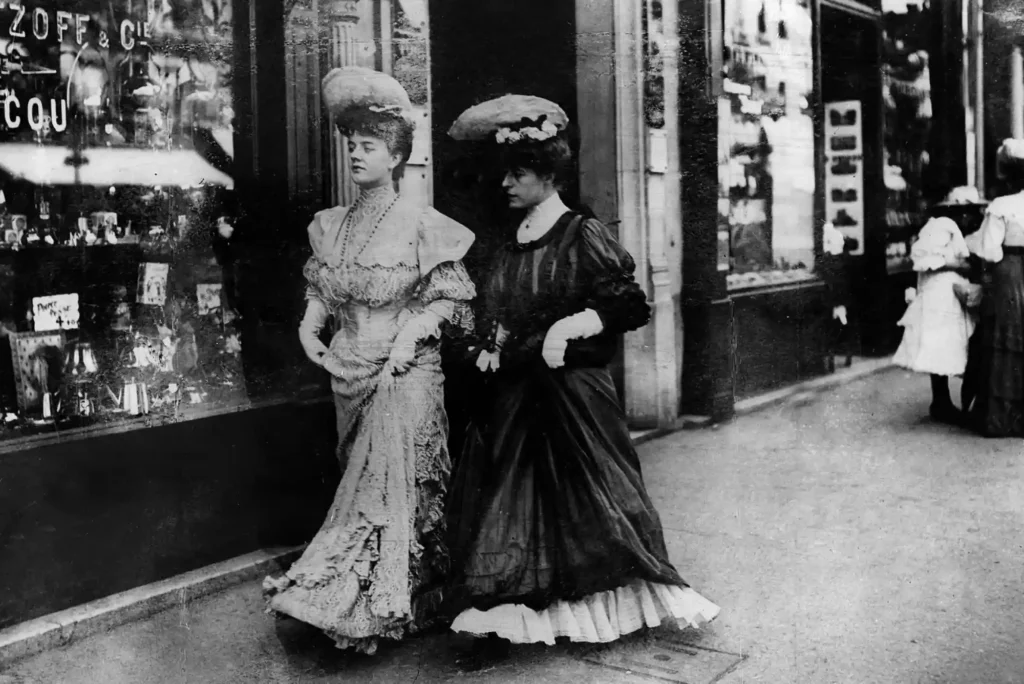The fashion scene in 1905 was one of dynamic change and transformation, both in Italy and globally. During this period, the country was experiencing profound social, political, and cultural shifts. Women’s fashion, in particular, was evolving rapidly, and Italy was at the forefront of these changes. The period marked the tail end of the Edwardian era and the beginning of the modernist movements that would dominate the 20th century. Italian women’s clothing style during this time was characterized by elegance, class, and a touch of opulence. From luxurious fabrics to innovative silhouettes, Italy’s influence on global fashion was growing stronger, and women embraced a combination of traditional tailoring and emerging fashion trends.
The Cultural Context of Fashion in 1905 Italy
To truly understand Italy’s clothing style for women in 1905, it’s important to look at the social and cultural backdrop. At the turn of the century, Italy was unifying politically, but socially and culturally, it was still divided between the north and south. Fashion, especially in cities like Milan, Rome, and Florence, was evolving in response to both the old world and the new. Italy had a strong tradition of artisanal craftsmanship, and this was reflected in the high-quality textiles and intricate details of women’s clothing.

The women’s movement was gaining momentum in Italy, advocating for social and political rights, which in turn influenced fashion. Women in Italy, especially those from higher social classes, were beginning to experiment with styles that were not just fashionable but also symbolic of their growing independence and desire for change. The garments they wore were a reflection of both their societal roles and the shifting attitudes toward women’s rights.
The Key Features of Italian Women’s Fashion in 1905
Italian fashion for women in 1905 was about embracing femininity and grace, but with a modern twist. Here are some key features that defined the clothing style of women during this period:
S-Lines and Corsetry
The silhouette of 1905 was heavily influenced by the S-curve, a look that was popularized by designers like Paul Poiret and the House of Worth. This style was achieved with the help of a tight-fitting corset that pushed the chest forward and the hips back, creating an exaggerated hourglass shape. This silhouette was not only considered fashionable but also served as a symbol of femininity and refinement.
Corsets were worn under dresses and skirts, which were often long and flowing, with layers of fabric that draped elegantly. The waist was cinched, emphasizing the feminine form, while the voluminous skirts created a sense of drama and grandeur.
Elaborate Dresses and Gowns
The dresses worn by Italian women in 1905 were characterized by intricate details, including lace, embroidery, and beading. These garments were often made from luxurious fabrics such as silk, satin, and velvet, and were designed to highlight the wearer’s elegance. High collars, puffed sleeves, and long flowing skirts dominated the fashion scene.
Evening wear was particularly elaborate, with designers such as Mariano Fortuny beginning to influence the high society in Italy. Women in cities like Venice were known for their ornate gowns that combined classical influences with modern style. For the upper classes, fashion was an expression of status, and the more intricate the design, the more prestigious the woman wearing it was perceived to be.
Color Palette and Fabric Choices
The color palette for Italian women’s clothing in 1905 leaned toward rich, deep hues such as burgundy, midnight blue, and emerald green. Pastel colors were also common, especially in more casual, daytime wear. Fabrics such as silk, satin, wool, and cotton were widely used, with silk being the most coveted for special occasions.
The detailing on fabrics was equally important. Embroidered patterns, delicate lace trims, and velvet ribbons were all common features on dresses, jackets, and blouses. These fine details not only enhanced the garment’s beauty but also served as an indication of the wearer’s wealth and taste.
Tailored Suits and the Shift Toward Practicality
By 1905, women’s fashion was beginning to move away from the purely ornamental toward more practical designs. While the corset was still a staple of many outfits, women in Italy, especially in more urban areas, were starting to adopt tailored suits for everyday wear. These suits featured high collars, straight lines, and simpler cuts, allowing women more freedom of movement compared to the highly structured dresses of earlier decades.
Many of these suits were made of wool and featured jackets with long sleeves and decorative buttons. They were often worn with skirts that were shorter than the traditional full-length versions, reflecting the beginning of a more relaxed approach to fashion.
Hats and Accessories
Accessories played a significant role in Italian women’s fashion in 1905. Wide-brimmed hats were incredibly fashionable, and they were often adorned with feathers, flowers, ribbons, and lace. The hats were designed to complement the elaborate gowns and dresses, adding another layer of sophistication and glamour.
In addition to hats, women wore gloves, often elbow-length, and carried handbags that were crafted from luxurious materials. Jewelry, such as pearls and brooches, were common accessories that added a touch of opulence to a woman’s outfit.
The Influence of Italian Fashion on the Global Stage
Italian fashion in 1905 was not just confined to Italy; it was beginning to have a profound influence on fashion trends worldwide. Milan was becoming an international hub for fashion, with many Italian designers gaining prominence for their ability to blend artistic tradition with modern styles. The craftsmanship of Italian clothing was renowned, and women around the world sought to emulate the Italian ideal of elegance.
Designers like Mariano Fortuny, who was based in Venice, were pioneers in creating garments that were both artistic and wearable. Fortuny’s designs, in particular, were influential in shaping the aesthetic of the time, blending the opulence of the past with the modern spirit of innovation.
The Changing Role of Women and Its Impact on Fashion
Fashion in 1905 Italy was also shaped by the changing role of women in society. The turn of the century saw the rise of women in the workforce, particularly in northern Italy, where industrialization was taking root. This shift influenced their clothing choices, as women began to dress more for function and comfort, alongside style and formality.
The suffragette movement, which was gaining traction worldwide, also had an impact on fashion. Although Italy was slower than other European nations to grant women voting rights, the fight for equality was beginning to influence women’s clothing, especially in the growing feminist circles in cities like Rome and Milan. Women started to move away from overly restrictive garments, adopting more practical and comfortable clothing choices, especially as they became more active in public life.
The Italian Influence on Global Fashion Design
As Italian designers and stylists influenced international fashion trends, their impact became undeniable. Cities like Paris and London, which had long been the capitals of fashion, began to adopt certain elements of Italian style. However, Italy’s contribution was more than just aesthetic; it was about quality craftsmanship, which made Italian fashion a hallmark of luxury and class.
Italian women’s clothing in 1905 set the stage for the modern Italian fashion industry that would explode in the decades to come. The legacy of Italian craftsmanship and design continues to be celebrated in the fashion world, with Milan standing as one of the most prominent fashion capitals in the world today.
The clothing style for women in Italy in 1905 was a beautiful mixture of tradition, innovation, and cultural significance. As Italy evolved socially and politically, so did its fashion, reflecting the changing roles of women and the country’s rising importance on the world stage. The elegance and sophistication of Italian women’s fashion during this period not only shaped the trajectory of Italian design but also had a lasting influence on global fashion trends for years to come.
Table: Key Features of Italian Women’s Fashion in 1905
| Feature | Description |
|---|---|
| Silhouette | S-line shape, corsets, hourglass figure |
| Fabrics | Silk, satin, velvet, cotton, lace, and embroidered fabrics |
| Colors | Rich hues like burgundy, midnight blue, and pastel shades |
| Accessories | Wide-brimmed hats, gloves, jewelry, handbags |
| Tailoring | Tailored suits for everyday wear, more relaxed fit |











